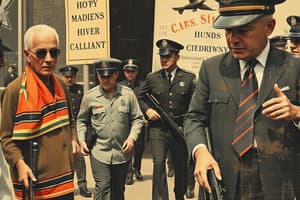Podcast
Questions and Answers
What constitutes Disorderly Conduct under (a)(1)?
What constitutes Disorderly Conduct under (a)(1)?
- Making an offensive gesture
- Fighting with another person
- Creating a noxious odor
- Using abusive language in a public place (correct)
What actions could lead to an offense under Disorderly Conduct (a)(2)?
What actions could lead to an offense under Disorderly Conduct (a)(2)?
- Exposing genitals in a public place
- Fighting another person
- Making an offensive gesture in a public place (correct)
- Discharging a firearm in a public place
What is an example of Disorderly Conduct under (a)(3)?
What is an example of Disorderly Conduct under (a)(3)?
- Abusing a person in a public place
- Making unreasonable noise
- Displaying a weapon
- Creating a noxious odor in a public place (correct)
What is prohibited under Disorderly Conduct (a)(4)?
What is prohibited under Disorderly Conduct (a)(4)?
What type of noise can be regarded as unreasonable under Disorderly Conduct (a)(5)?
What type of noise can be regarded as unreasonable under Disorderly Conduct (a)(5)?
What happens under Disorderly Conduct (a)(6)?
What happens under Disorderly Conduct (a)(6)?
Which conduct is restricted under (a)(7)?
Which conduct is restricted under (a)(7)?
What is considered Disorderly Conduct under (a)(8)?
What is considered Disorderly Conduct under (a)(8)?
What does Disorderly Conduct (a)(9) say about firearms?
What does Disorderly Conduct (a)(9) say about firearms?
What can lead to an offense under Disorderly Conduct (a)(10)?
What can lead to an offense under Disorderly Conduct (a)(10)?
What types of actions fall under Disorderly Conduct (a)(11)?
What types of actions fall under Disorderly Conduct (a)(11)?
What is defined as a public place under (a-1)?
What is defined as a public place under (a-1)?
It is a defense to prosecution under Subsection (a)(4) if the actor had significant provocation.
It is a defense to prosecution under Subsection (a)(4) if the actor had significant provocation.
Under Disorderly Conduct (c), what constitutes an act occurring in a public place?
Under Disorderly Conduct (c), what constitutes an act occurring in a public place?
What class of misdemeanor is an offense under this section?
What class of misdemeanor is an offense under this section?
It is a defense under (e) that the person discharged a firearm due to fear of a dangerous wild animal.
It is a defense under (e) that the person discharged a firearm due to fear of a dangerous wild animal.
Subsections (a)(1), (2), (3), (5), and (6) apply to students younger than 12 at a public school during regular hours.
Subsections (a)(1), (2), (3), (5), and (6) apply to students younger than 12 at a public school during regular hours.
Noise from lawful space flight activities is considered unreasonable noise.
Noise from lawful space flight activities is considered unreasonable noise.
Flashcards are hidden until you start studying
Study Notes
Disorderly Conduct Definitions and Elements
- Disorderly Conduct (a)(1): Offense occurs when a person uses abusive or profane language in a public place, inciting immediate breach of the peace.
- Disorderly Conduct (a)(2): Offense occurs when a person makes an offensive gesture or display in public that tends to incite a breach of peace.
- Disorderly Conduct (a)(3): Offense occurs when a person creates noxious odors using chemical means in a public space.
- Disorderly Conduct (a)(4): Offense occurs when a person abuses or threatens another in a public place in a clearly offensive manner.
- Disorderly Conduct (a)(5): Offense occurs when a person makes unreasonable noise in public areas excluding sport shooting ranges or private residences not occupied by them.
- Disorderly Conduct (a)(6): Offense occurs when a person engages in a fight with another individual in a public place.
- Disorderly Conduct (a)(7): Offense occurs when a person discharges a firearm in a public place not defined as a public road or sport shooting range.
- Disorderly Conduct (a)(8): Offense occurs when a person displays a firearm or deadly weapon publicly in an alarming manner.
- Disorderly Conduct (a)(9): Offense occurs when a person discharges a firearm across a public road.
- Disorderly Conduct (a)(10): Offense occurs when a person exposes their genitals or anus in public, being reckless about offending others.
- Disorderly Conduct (a)(11): Offense occurs by looking into areas providing privacy for lewd or unlawful purposes, including homes, hotel rooms, or restrooms.
Public Place Definition
- Public Place (a-1): Defined to include public school campuses and surrounding grounds for purposes of disorderly conduct offenses.
Legal Defenses and Provisions
- Disorderly Conduct (b): Significant provocation serves as a defense for abusive or threatening conduct under Subsection (a)(4).
- Disorderly Conduct (c): Acts are considered public if they produce consequences in public spaces or near private residences; noise over 85 decibels is presumed unreasonable after notice of public nuisance.
- Disorderly Conduct (d): Most offenses are Class C misdemeanors; offenses under (a)(7) or (a)(8) are Class B misdemeanors.
- Disorderly Conduct (e): Discharging a firearm can be defensible if done out of reasonable fear of bodily injury from dangerous wild animals.
- Disorderly Conduct (f): Children under 12 are not subject to specific prohibitions during regular school hours at public school campuses.
- Disorderly Conduct (g): Noise from lawful space flight activities is not deemed unreasonable for purposes of these laws.
Studying That Suits You
Use AI to generate personalized quizzes and flashcards to suit your learning preferences.




